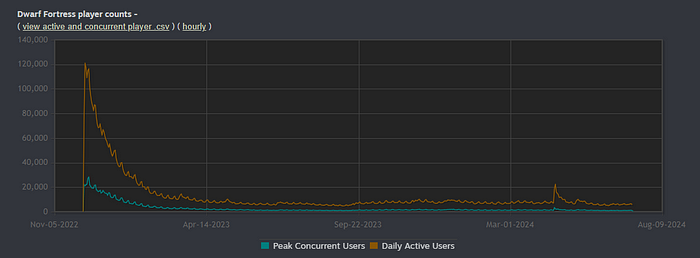Doing Early Access the “Right Way”
by Tanya X. Short and Alexandra Orlando
Tanya X. Short is an opinionated game designer and business developer who works as the co-founder and lead of Kitfox Games. Alexandra Orlando is the community and marketing manager of Kitfox Games.
Lots of people have opinions about launching a game into Steam Early Access (EA) and its potential pitfalls, the right way to do it, etc. But we think the human element has been largely missing from the conversation, so we thought we’d speak up, as the publishers of Caves of Qud, one of the Early Access darlings, as well as Dwarf Fortress and potentially other Early Access(-ish?) titles from small teams.
For this article, we’re going to assume you have a game that’s well-suited to Early Access. It’s easy to update and the player experience exponentially gains value from updates. It’s extremely replayable, moreso than (for example) our own Moon Hunters or Boyfriend Dungeon. It’s a design that can meaningfully benefit from an extended public playtesting period. OK, so you’re confident it could be a good fit for Early Access. Cool.
It’s reasonable then to wonder: What state should your game be in when it comes to Early Access? How do you respond to an apparent success and capitalize on it? Which games are doing it right?
What is the formula for developing such a game “properly” to avoid Early Access problems?
The short answer is, “every game is different and made by different people”. Not helpful for byte-size hot takes, but the honest truth, from where we’re sitting.
Let’s talk about the top 3 answers we’ve seen to the question, and the pitfalls each offers.
The Early Access Formulas
Answer 1: Locked and Loaded, a.k.a. do it like Hades

This is the gold-standard advice. Your game, likes Hades, should be virtually complete even when it hits EA, with only small art changes and balancing left, and a clear path from launch to full release. A full team committed to regular, fully-communicated, predictable updates. The advantages are obvious when this strategy works — you take your success and grow it, with a lot of work, under the hot eyes and hands of the mainstream gamer.
The tradeoffs of this strategy are not as obvious, especially to those happy gamers, but we’ll get to that in a moment.
Answer 2: Skip It, a.k.a. do it like Dwarf Fortress
A cheeky answer for many reasons, chief among which is that it was never actually in the official Steam Early Access program at all. Partly because Early Access didn’t exist back in 2006 (let’s be honest, Steam itself barely did), but partly because the creators wanted to keep expectations low, by giving it away for free/donations.
When we agreed to publish Dwarf Fortress, it was not a new IP. The developers Tarn and Zach Adams were extremely aware that the Steam launch would be high-pressure due to sheer player numbers — in fact, buffering them from that heat was a huge part of the job.

But ultimately, the reason that buffering was helpful is because the devs don’t really care (and don’t want to care) about “capitalizing” on their success. They just want to live a comfortable life working on their game. Dwarf Fortress had a peak concurrent user count over 120,000 at launch in December 2022 and a year and a half later the Adventure Mode beta snuck players back up above 20,000. Visually, this looks like:

Will Dwarf Fortress ever have 120,000 concurrent players again? Maybe, but probably not? Does that bother anyone? Not that I’m aware of.
It’s fine if we’ve “peaked”. We’re not here to make as much money as possible. (Yes, we do sell Dwarf Fortress merch, but the profits from that are extremely minor. It’s just a fun thing for the devs and fans to enjoy.)
But Dwarf Fortress mostly side-stepped Early Access not for reasons of sales or profits, but because the devs and Kitfox agreed it wasn’t a good fit for a game that never really intended to ever be fully “complete”.
In an ideal world, Dwarf Fortress would live on in some continuing-to-improve form even in another 100 years, so we didn’t want to have to declare some sort of arbitrary “1.0” status. Functionally, the free, donations-only ASCII version was the Dwarf Fortress take on Early Access, and what’s on Steam now is the “full” version, which will continue to grow and evolve for as long as possible.
This strategy also has tradeoffs and disadvantages, and not just “lower profits(?)”. We’ll get to those in a moment too.
Answer 3: Give ‘em What They Want, a.k.a. Caves of Qud
This is also a cheeky answer because it didn’t peak at launch exactly, but Caves of Qud by Freehold Games DID have a huge spike years before they fell in with Kitfox (we signed them as publishers in mid-2023), shown here:

As you can see, improvements to the game and beating that marketing drum has caused the concurrent users to grow steadily, and we allow ourselves to hope that the 1.0 release later this year will overtake that 2020 spike.
Caves of Qud is indeed benefiting from following the standard Early Access “formula” of success:
- it’s a game with highly replayable “infinite” content to explore
- the devs update the game weekly
- the devs themselves practice high visibility and frequently address community concerns
- the updates haven’t substantially changed the fundamental appeal of the game
But when lightning struck out of the blue in 2020, with a huge YouTuber directing record sales to the game, Freehold were not able to fully “capitalize” on it immediately. Part of the problem was that the YouTuber in question literally directed his followers to harass the developers, so even though their main community was supportive, a huge amount of their interactions in the wake of this “success” was just managing hate.

But even in the best of cases, with a tiny team (2, most of the time), growth has to be the patient, steady, tortoise-like growth. This would have been true on launch as well — if that concurrent user spike had been in 2015, and friendly, it might still have taken until 2023 for them to start seeing those numbers approaching again.
Okay so now for the salty tea-spilling! All of these answers are painful in their own special way!
The Downsides
1. Locked and Loaded (Hades)
Hades and Hades II are easy to rhapsodize about and try to emulate because hey, they’re successful, they’re beautiful, they’re unique, and Supergiant are wonderful folks. We love this for them.
But even if you can afford to do this, and have the team that can execute accordingly, this “formula” isn’t useful for games that are extremely innovative or deeply complex, where the devs literally cannot know how many years (decades?) it will take to “finish”, or where the whole concept of completion might be bizarre. Hades is not a shallow game by any means, but it’s square within the roguelite genre and nobody’s trying to sell it on the intricate, emergent depth.

Now, when we asked the Caves of Qud devs to review this post, they pointed out that the through-line between all 3 of these games (Hades, Dwarf Fortress, Caves of Qud) was overwhelmingly positive response at the start. Early Access is simply not the place to test-market the game, so even if your game can’t be “almost finished”, you should be certain that you’re ready to launch into already extremely positive review status, and if you won’t, you shouldn’t do it.
All art is never finished and only abandoned, as they say. But plenty of games have already been burned by an unready game hopping into Early Access before it was ready. Speaking of which, what if you…
2. Skip It (Dwarf Fortress)
Dwarf Fortress was never an Early Access game, or maybe it always is. So in some ways nobody (or everybody?) can complain that it was harmed by Early Access development. The game will continue with updates “forever”.
Except when it’s a tiny team, working on an increasingly complex game, those updates can’t be extremely predictable. If someone gets sick, or goes on a honeymoon, or moves countries, well, 50% of the development velocity is gone, and you just have to accept that.
Even worse, Steam in particular has trained people to expect games in active development to get weekly updates, constantly communicated roadmaps, and regular sizable content drops. Steam doesn’t surface team size or development philosophy. The community has very few ways to see or understand why a developer wouldn’t be able (or want) to update weekly, or sometimes even monthly — this other game has big updates constantly, why don’t you? (We’re actually in the midst of drafting a community FAQ about this that might help, wish us luck.)
So if you were hoping to escape the gamer-demand treadmill by skipping Early Access, that’s not going to work. The traps and pitfalls remain. The marathon doesn’t end with 1.0. The marathon only ends when you say it ends.
But what’s wrong with just embracing the marathon? Well.
3. Give ’em What They Want (Caves of Qud)
Everything’s coming out roses for Caves of Qud and its strategy, but here’s where you have to remember some special qualities of the highly engaged, community-oriented Qud devs:
- they’re very experienced developers
- they primarily want a positive lifestyle and great game, rather than maximum profit
- they’re not particularly bothered by haters or negative feedback
All of these not only make the marathon-treadmill of updates possible, but pleasurable. If, however, they were less experienced, or took more psychic damage from negative reviews, this approach might be way too grueling. Or your laptop might get stolen (don’t forget version control). And if you do take a long time between patches, how long is too long? How much (sometimes very personal) backlash can you endure while also trying to write code?
It’s also much harder than it sounds to “react to community concerns”. There’s multiple ways it can go wrong, even assuming you don’t take psychic damage from reading the comments at all (which is unusual):
- you took their complaint and solution way too literally
- you listened to a vocal minority and ruined it for the quiet majority
- you strayed too far from the initial vision/promise of the game
- you lost interest in the game because you forgot why you made it
- you spent all day reading the forums and now there’s no time left to dev
So, none of these answers are perfectly suited to anyone or anything. Now what?
The Actual Formula for Early Access Success
Drumroll…
To say it plainly, there isn’t one.

The best advice we can give as a blanket, not knowing who we’re talking to:
- Know thyself. Do you really want maximum profit, or do you want to preserve a certain lifestyle? What are you willing to risk for those? How thick is your skin, when it comes to completely unfounded and/or deeply unfair criticism?
- Know thy game. What strengths and weaknesses does it offer to Steam as an ecosystem, and Early Access in particular?
- Do your best. Ultimately, that’s all we can do. If you keep an open mind, all mistakes are learning moments, tailor-made specially for you.
We actually just signed another title we’re going to help complete their Early Access in the coming year(s?), but I can’t announce it today. Fingers crossed we can continue to learn from them and their game, and then you can too.
This won’t be the last conversation about Early Access, or First Access, or Closed Alpha, or LiveOps, or whatever weird marketing term appears next. But more of these discussions should focus on the people doing the work, and why, and what risks they’re undertaking.
Developers aren’t interchangeable.
